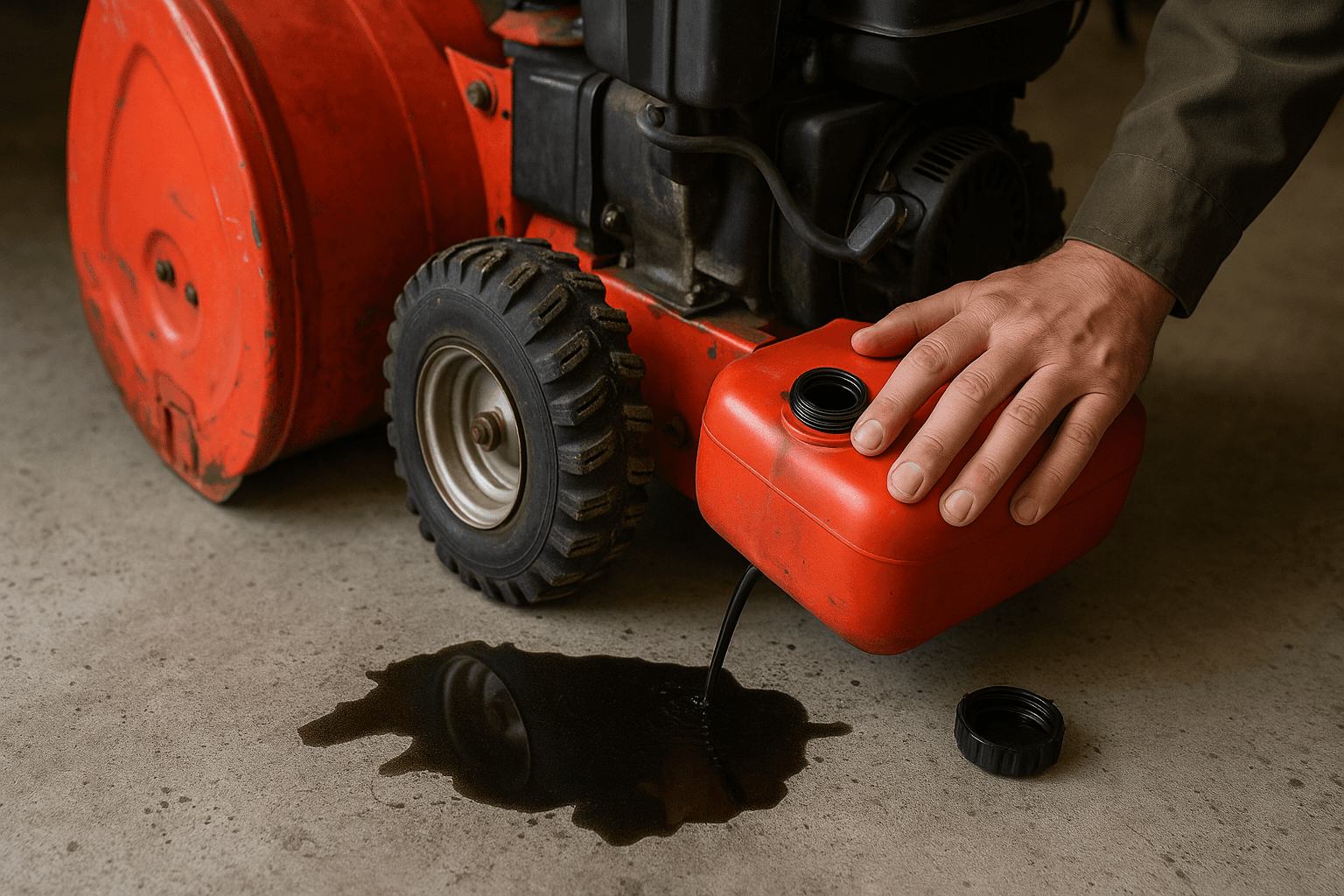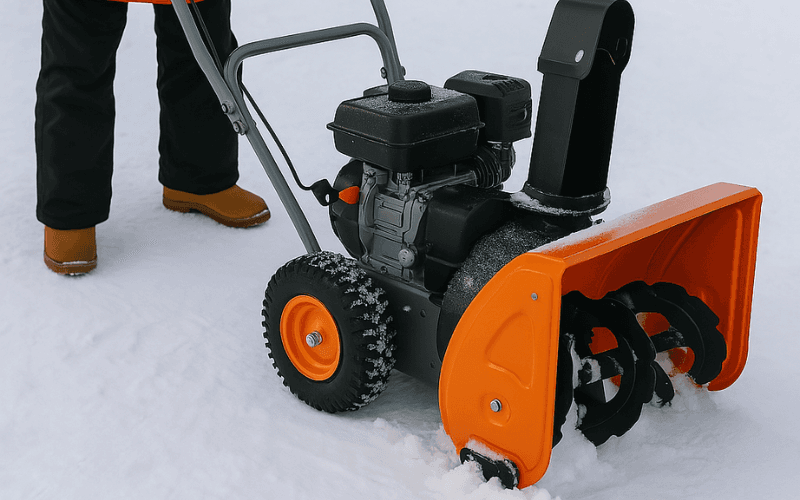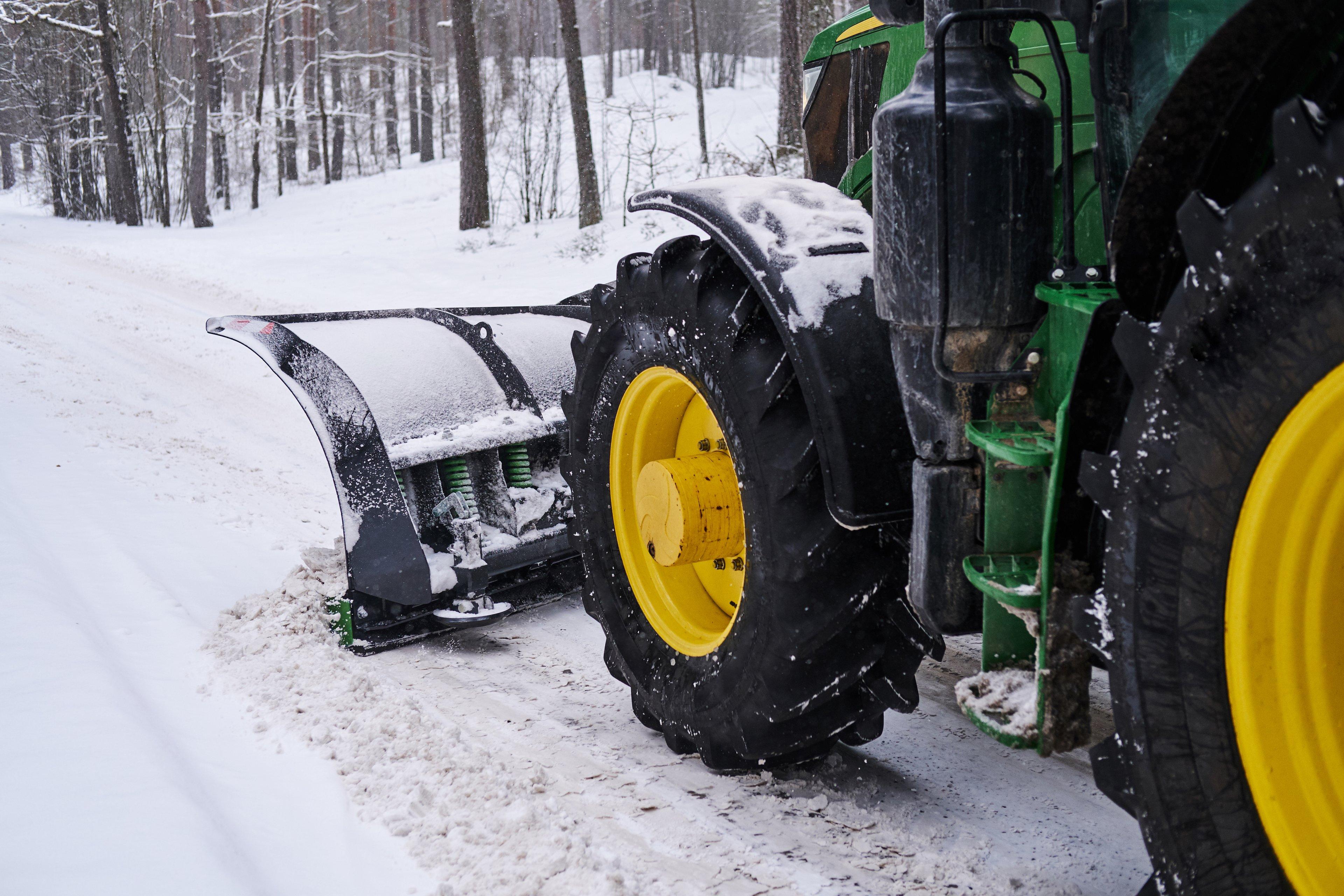Repair help
8 Place SnowBlower Leaking Gas - Causes and How to Fix
AZparts Team
Updated on June 18, 2025
13 min read
The snow blower is leaking gasoline, possibly from the carburetor, fuel line, or fuel tank. This issue may cause a strong gas smell, visible drips, or puddles beneath the machine. It is important to stop using the snow blower immediately and inspect for cracks, loose connections, or worn-out gaskets. In this article, AZParts will guide you through the common reasons why your snow blower might be leaking gas, how to diagnose the issue, and what steps you can take to fix it.

1. Common Signs Your Snow Blower Is Leaking Gas
A gas leak in your snow blower is more than just a fuel waste; it can be a fire hazard and a signal of deeper mechanical issues. Identifying the signs early can help prevent damage and ensure safe operation. Below are the most common signs that your snow blower may be leaking fuel.
1.1. Strong gasoline smell in storage
If you notice a persistent smell of gasoline in your garage or storage area, even when the snow blower hasn’t been used recently, this could indicate a fuel leak. This smell may come from evaporating gas due to a compromised fuel line, loose carburetor fittings, or a worn-out fuel tank gasket.
Gasoline with ethanol tends to evaporate more quickly and can degrade rubber components over time, increasing the chance of leakage.
1.2. Visible wet spots or puddles under the unit
Observable signs of moisture or water puddles beneath the unit (Source: AZParts)
Finding wet spots or small puddles beneath your snow blower is one of the clearest indications of a leak. These spots are usually found under the fuel tank, carburetor, or fuel lines. Common causes include:
- Cracked or hardened fuel lines
- Leaky carburetor bowl
- Loose fuel shut-off valve connections
Try placing a clean piece of cardboard or a paper towel under the machine overnight to check for active dripping.
See more: How to Clean A Snow Blower Carburetor
1.3. Engine hard to start or stalls
A leaking fuel system can cause air to enter the fuel lines or reduce fuel pressure, making the engine difficult to start. You might also experience:
- The engine starting but stalling after a few seconds
- Rough or uneven idle
- Sudden engine shutdown during operation
If the spark plug, air filter, and oil levels are all in good condition, but the issue persists, you should inspect the fuel system for leaks.
Maintenance Tip: Always use fresh gasoline with no more than 10% ethanol to protect the fuel system. If storing gas for more than 90 days, add a fuel stabilizer. Regularly inspect fuel lines and carburetor seals for cracks or wear.
2. Top 8 Places of Gas Leaks in Snow Blowers (And How to Fix Them)
Gas leaks in snow blowers are not only wasteful but can also pose serious safety hazards. Understanding the most common leak points will help you fix issues quickly and keep your machine running smoothly. Let’s dive into the top spots where gas leaks usually happen and how to handle each one.
2.1. Cracked Fuel Line
Signs of a Cracked Fuel Line
- Strong smell of gasoline near the engine.
- Visible wet spots or drips along the rubber fuel hose.
- Snow blowers run inconsistently or won’t start.
Cracked Fuel Line in Snow Blower (Source: AZParts)
Why It Happens
Fuel lines, typically made of rubber or plastic, can become brittle over time due to cold weather, ethanol in gas, or simple aging. Cracks or pinholes allow fuel to escape, leading to performance issues or fire risk.
How to Fix It
- Step 1: Turn off the engine and disconnect the spark plug for safety.
- Step 2: Inspect the entire length of the fuel line for any visible damage.
- Step 3: Replace the fuel line entirely, do not attempt to patch or shorten and reconnect.
Bonus Tip: Use fuel lines rated for ethanol-blended gasoline to extend longevity.
2.2. Leaky Fuel Tank
Signs of a Leaky Fuel Tank
- Puddle of gas forming under the unit after it’s been parked.
- Constant fuel loss even when the machine is off.
- Visible cracks or stains near the base or seams of the tank.
Why It Happens
Fuel tanks are exposed to vibrations, temperature fluctuations, and internal pressure buildup. Over time, this can cause plastic tanks to crack or metal tanks to corrode. In many cases, the leak starts small and grows worse with use.
How to Fix It
- Step 1: Drain all fuel from the tank to prevent spills.
- Step 2: Carefully inspect the tank for any cracks, pinholes, or seam failures.
- Step 3: Replace the tank entirely if damage is visible — sealing agents may provide temporary relief but aren’t reliable long-term.
Bonus Tip: When replacing, ensure the new tank is compatible with your snow blower model.
2.3. Faulty Fuel Shutoff Valve
Signs of a Faulty Fuel Shutoff Valve
- Gasoline continues to drip even when the shutoff valve is in the OFF position.
- Fuel smell near the valve area.
- Wet fuel stains or pooling beneath the valve connection.
Faulty Fuel Shutoff Valve in Snow Blower (Source: AZParts)
Why It Happens
Over time, the internal seals of the fuel shutoff valve can degrade, or the valve body may crack due to freezing temperatures or fuel corrosion. Additionally, rough handling during seasonal maintenance can weaken the connections.
How to Fix It
- Step 1: Turn the valve to the OFF position and disconnect the fuel line.
- Step 2: Inspect for cracks, corrosion, or wear around the valve body.
- Step 3: Replace the valve with a compatible shutoff valve if any damage is found.
Note: Always ensure tight, snug hose connections when reinstalling but do not overtighten.
2.4. Loose Fuel Line Connections
Signs of Loose Fuel Line Connections
- Small but persistent gas drips around hose clamps or fittings.
- Engine stalls or has trouble maintaining fuel pressure.
- Fuel lines can be twisted or easily pulled off fittings.
Why It Happens
Fuel lines may become loose over time due to vibration, poor installation, or degraded hose clamps. Temperature shifts can also shrink or expand fittings, leading to imperfect seals.
How to Fix It
- Step 1: Power off the snow blower and remove the spark plug cap for safety.
- Step 2: Check all hose ends and fittings, especially around the carburetor, fuel filter, and shutoff valve.
- Step 3: Re-seat any loose connections and replace worn-out hose clamps with stainless steel ones.
Tip: A snug, even seal is critical. Avoid over-tightening, which may damage plastic fittings.
2.5. Damaged Primer Bulb
Snow Blower has Damaged Primer Bulb (Source: AZParts)
Signs of a Damaged Primer Bulb
- Gas visibly leaks when the bulb is pressed.
- Bulb feels cracked, hardened, or won’t return to shape.
- Engine becomes hard to start, especially in cold weather.
Why It Happens
Primer bulbs are made of rubber, which deteriorates with time and exposure to fuel and UV light. Cold climates can accelerate cracking, and ethanol-blended gasoline can dry out the rubber.
How to Fix It
- Step 1: Identify the correct primer bulb for your snow blower model.
- Step 2: Remove the old bulb by gently pulling it from its mount or unscrewing the retaining ring.
- Step 3: Install a new bulb and test for leaks by priming the engine.
Note: Always replace the bulb with one rated for your specific fuel type and carburetor setup.
2.6. Overflowing Carburetor Bowl
Signs of an Overflowing Carburetor Bowl
- Steady drip or small stream of gas from the bottom of the carburetor.
- Strong fuel odor near the engine even when off.
- Wet carburetor area and difficulty starting the engine.
Why It Happens
Inside the carburetor, a float controls the flow of fuel into the bowl. If the float or the float needle is stuck, dirty, or worn, it may fail to shut off the fuel flow causing the bowl to overflow.
How to Fix It
- Step 1: Shut off fuel supply and remove the carburetor bowl.
- Step 2: Inspect the float and needle for wear, damage, or dirt buildup.
- Step 3: Clean or replace faulty components. If multiple parts are worn, use a carburetor rebuild kit.
Pro Tip: Soak the carburetor in the cleaner overnight for deep cleaning if buildup is heavy.
2.7. Leaking Carburetor Gasket
Leaking Carburetor Gasket in Snow Blower (Source: AZParts)
Signs of a Leaking Carburetor Gasket
- Gas seeping from the seam between the carburetor bowl and the main body.
- Damp fuel residue under the carburetor.
- Poor engine performance or random stalling.
Why It Happens
The gasket (seal) between the carburetor body and its bowl can dry out, crack, or shift over time, especially with exposure to fuel, heat, and vibration. A poor seal allows fuel to leak out during normal operation.
How to Fix It
- Step 1: Drain the fuel and remove the carburetor bowl.
- Step 2: Carefully remove the old gasket and clean the sealing surface.
- Step 3: Install a new gasket to make sure it matches your carburetor model.
Bonus Tip: Avoid using sealant or glue as it can clog jets inside the carb.
2.8. Vapor Lock or Fuel Cap Vent Issue
Signs of a Vapor Lock or Blocked Fuel Cap Vent
- Intermittent fuel leaks after running for a while.
- Engine stalls and won't restart until the cap is loosened.
- A “whoosh” sound when opening the gas cap.
Why It Happens
Fuel caps have a tiny vent that allows air into the tank as fuel is used. If this vent is blocked, a vacuum forms, disrupting fuel flow. In some cases, pressure buildup can force gas through seals or overflow tubes.
How to Fix It
- Step 1: Inspect the fuel cap for dirt, blockages, or damage.
- Step 2: Clean the vent hole using a small needle or replace the cap if clogged or cracked.
- Step 3: Avoid overfilling the tank, which can worsen the issue.
3. When to Repair and When to Replace Parts
Dealing with a gas leak in your snow blower often leads to a critical decision: Should you repair the part or replace it entirely? Understanding the difference can save you time, reduce future breakdowns, and keep your equipment running safely through winter.
Know when to need repair or replace snowblower parts (Source: AZParts)
3.1. When a Repair Is the Right Solution
Repairing a component is appropriate when the issue is minor, and the part is still structurally sound. In many cases, small problems can be resolved quickly without the need for full replacement.
Common situations where repair makes sense:
- The fuel line is slightly loose but not cracked, a clamp adjustment may suffice.
- The float needle in the carburetor is dirty or stuck, cleaning with a carburetor cleaner can restore function.
- A gasket shows no major cracks but is slightly misaligned, it may only need repositioning or tightening.
If the part is relatively new and hasn’t been degraded by ethanol-based fuel, cleaning or reseating might be all you need. This is especially true for issues involving fuel flow control components like the float or fuel shut-off valve.
However, if the issue recurs after repair or worsens under pressure, it may be time to replace.
3.2. When Replacement Is the Better Choice
There are many cases where replacement is the only safe and reliable option. Snow blower parts are often exposed to fuel, cold temperatures, and engine vibrations — all of which accelerate wear and tear.
You should replace the part if:
- It is cracked, leaking, warped, or physically damaged.
- Rubber parts (fuel lines, primer bulbs, gaskets) have become brittle, shrunk, or hardened.
- There are recurring leaks even after attempted repairs.
- The component is over 3–5 years old or shows signs of ethanol damage.
- The carburetor housing, tank, or shut-off valve is leaking despite cleaning and adjustments.
Examples of parts that typically require replacement:
- Leaking primer bulbs or cracked fuel lines
- Degraded carburetor gaskets
- Faulty fuel shut-off valves that won’t close properly
- Carburetors with broken threads or internal cracks
Attempting to glue or patch cracked plastic or rubber components may offer a temporary fix but often leads to bigger leaks or even fire hazards. When in doubt, replacement is the safer long-term option.
When replacement is necessary, it’s essential to choose reliable, high-quality parts that are compatible with your equipment. AZParts specializes in snow blower replacement components from carburetor rebuild kits and fuel shut-off valves to primer bulbs, hoses, and fuel tanks. With a wide inventory and expert support, AZParts makes it easy to find the exact snow blower part you need to restore your machine to peak performance.
4. How to Prevent Gas Leaks in the Future
Preventing fuel leaks in your snow blower not only saves you money but also ensures safety and reliable operation during the cold months. Implementing simple best practices can significantly reduce the risk of gas leaks and extend the life of your equipment.
4.1 Use Fresh Fuel and Avoid Ethanol Blends
Using the right fuel for snow blower to avoid issues in the future (Source: AZParts)
One of the most common causes of fuel system problems is degraded or contaminated gasoline. Always use fresh fuel from a reputable source to avoid buildup of varnish and deposits inside fuel lines and the carburetor. Additionally, avoid gasoline blends with high ethanol content, as ethanol can absorb moisture and cause rubber and plastic components to deteriorate faster. If you must use ethanol-blended gas, consider adding a fuel stabilizer designed for cold weather equipment.
4.2 Store the Machine Properly
Storing the snow blower during off-season months is critical to prevent fuel leaks and other damage.
- Use a snow blower cover to protect the machine from dust, moisture, and pests during storage. A quality cover helps maintain clean surfaces and prevents corrosion or damage caused by environmental exposure.
- Drain the fuel tank completely or run the engine until it uses all fuel to prevent stale gasoline from sitting in the system.
- Remove and clean the primer bulb and carburetor bowl if possible.
- Store the machine in a dry, sheltered location away from extreme temperatures and direct sunlight, which can accelerate rubber aging.
- Regularly inspect fuel lines, gaskets, and seals for signs of brittleness or cracks during storage.
4.3 Regular Maintenance Checklist
Maintaining snowblower is good way to extend snowblower performance (Source: AZParts)
Snowblower maintenance is the best way to catch potential fuel leaks early and keep your snow blower running smoothly. Create a maintenance checklist that includes:
- Inspecting all fuel lines and clamps for cracks, looseness, or wear.
- Checking and replacing primer bulbs and fuel shut-off valves as needed.
- Cleaning or rebuilding the carburetor annually to prevent float and needle sticking.
- Ensuring fuel filters are clean and intact.
- Tightening loose hose connections and replacing worn gaskets.
By following a regular maintenance schedule, you reduce the risk of unexpected leaks and costly repairs.
5. FAQs about Snow Blower Leaking Gas
5.1. Why is my blower leaking gas?
Gas leaks usually occur somewhere between the fuel tank and the engine carburetor. Common causes include cracked fuel lines, worn carburetor gaskets, faulty fuel shutoff valves, or damaged primer bulbs. Leaks can also be caused by using old or ethanol-blended fuel that degrades rubber and plastic components. Inspect these parts regularly to identify the leak source.
5.2. What does it mean if gas is coming out of the carburetor?
Gas leaking from the carburetor often indicates an overflowing carburetor bowl due to a stuck or damaged float or float needle. It can also result from a worn gasket or a cracked carburetor body. This issue causes excess fuel to spill, which is a fire hazard and will impact engine performance.
5.3. Why does my snowblower make my garage smell like gas?
A strong gasoline smell in your garage usually means there is a fuel leak or vapor escaping from the snow blower. Common sources include leaks from fuel lines, the carburetor, or a faulty fuel cap vent. It’s important to address this immediately to prevent fire hazards and ensure safe operation.
5.4. Should I drain the gas from my snowblower?
Yes, especially if you are storing the snow blower for an extended period (such as during the off-season). Draining the fuel prevents stale gasoline from causing clogs, varnish buildup, and damage to the fuel system components. Running the engine until it stops or using a fuel stabilizer can also help maintain fuel quality.
5.5. How to drain gas from a snowblower without draining it?
If you want to keep some fuel in the tank but avoid issues caused by old or contaminated gas, you can add a fuel stabilizer and run the engine for a few minutes. This circulates the stabilizer through the fuel system and helps preserve fuel quality without fully draining the tank. However, for long-term storage, fully draining the gas is still recommended.
A gas leak in your snow blower is a serious issue that shouldn’t be ignored. From cracked fuel lines to faulty carburetor components, identifying the source early can prevent performance problems, fire risks, and costly repairs. With proper maintenance and timely replacement of worn parts, you can keep your machine running safely all season long. For high-quality, compatible replacement parts, choose AZParts for your reliable source for snow blower repair solutions.
Contact Information:
- 8 The Green, Ste A, Dover, Delaware 19901-3618, United States
- support@azparts.com
Snowblower
Further Reading
Further Reading




_1747325797.png&w=3840&q=75)
